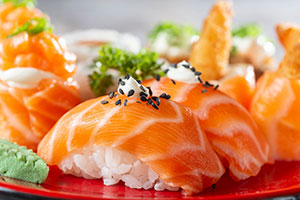
The consumption of raw foods has gained popularity for its numerous health benefits. Across cultures, raw foods have been celebrated for their natural nutrients and preservation of essential enzymes. Eating raw food has always been on my menu almost every time I eat out. One of my favorites are sushi and sashimi.
Other than its delicious taste, it also offers a range of health benefits, as they are rich in nutrients, enzymes, and antioxidants that support overall well-being. Japan, with its rich culinary heritage, has exemplified the art of raw cuisine through dishes like sushi and sashimi.
In this post we’ll explore and talk about the health benefits of incorporating raw foods into your diet, with a particular focus on the Japanese tradition.



But first, let me share some pictures of what my family had enjoyed in our recent dine-in at a Japanese restaurant called Misaki Bistro. We also tried natto and had free ice cream for my daugther.
The Japanese Tradition of Raw Foods
Japanese cuisine is a reflection of the country’s cultural values, where harmony and balance are highly cherished. Every aspect of a Japanese meal, from the selection of ingredients to the presentation on the plate, is carefully considered to achieve a harmonious balance of flavors, textures, and colors. The goal is to create a sensory experience that delights not only the taste buds but also the eyes and spirit.
The tradition of consuming raw foods has been nurtured for centuries. This practice is deeply rooted in the country’s geography and history, with its abundant access to fresh seafood and fertile lands for cultivating an array of vegetables. The combination of these factors has led to the creation of exceptional raw dishes like sushi and sashimi.
Sushi – A Masterpiece of Elegance

Sushi, perhaps the most well-known Japanese dish, is a true masterpiece of culinary elegance. It consists of small, hand-formed mounds of vinegared rice (shari) paired with various ingredients (neta) like raw fish (sashimi), cooked seafood, vegetables, and seaweed.
The art of sushi-making lies not only in the precise preparation but also in the careful selection of the ingredients to achieve a harmonious balance of flavors and textures. The result is a delightful marriage of simplicity and complexity, where each bite tells a story of craftsmanship and appreciation for the natural flavors.
Sashimi – Honoring the Essence of Fresh Seafood


Sashimi is a celebration of the essence of fresh seafood. It involves thinly sliced raw fish or seafood, presented without rice or other accompaniments, allowing the natural taste of the fish to take center stage. The preparation of sashimi requires a skilled hand, as the slices must be precise to achieve the perfect balance of taste and texture. For seafood connoisseurs, savoring sashimi is an experience that transcends the ordinary, as it embodies the ocean’s purity and the skills of those who prepare it.
Health Benefits of Eating Sushi and Sashimi
Indulging in sushi and sashimi, two delightful Japanese delicacies centered around raw fish and other wholesome ingredients, goes beyond a delectable culinary experience. The consumption of these dishes can bestow an array of health benefits, making them not just a treat for the taste buds but also a boon for overall well-being. Here are some of the key advantages of incorporating raw foods into your diet:
Rich in Omega-3 Fatty Acids
Both sushi and sashimi are primarily made with fatty fish like salmon, tuna, and mackerel. These fish are rich sources of omega-3 fatty acids, which promote heart health, reduce inflammation, and support brain function.
High Protein Content
Sushi and sashimi provide a substantial amount of high-quality protein, essential for muscle repair, cell growth, and immune system function.
Vitamins and Minerals
Sushi and sashimi, especially when accompanied by vegetables and seaweed, are packed with essential vitamins (e.g., vitamin A, D, B12) and minerals (e.g., iodine, selenium) that contribute to overall health and well-being.
Digestive Health
Raw foods are often high in dietary fiber, which is beneficial for digestive health. The fiber adds bulk to the stool and supports regular bowel movements, reducing the risk of constipation and promoting a healthy gut.
Weight Management
Raw foods are generally lower in calories and higher in fiber compared to processed foods. Including more raw options in your diet can help you feel full and satisfied with fewer calories, making it easier to manage your weight.
Proper Preparation of Raw Foods
While raw foods offer remarkable health benefits, proper preparation is crucial to ensure safety and reduce the risk of foodborne illnesses. Embracing the plethora of health benefits that raw foods offer requires a meticulous approach, taking into account the potential risks associated with consuming uncooked ingredients.
Source Quality Ingredients
Choose fresh, high-quality ingredients from reputable sources when preparing raw dishes. This is especially important for raw fish and meat.
Proper Storage
Keep raw foods refrigerated at the appropriate temperatures and separate from other ingredients to prevent cross-contamination. The proper storage at the recommended temperatures helps inhibit bacterial growth and preserves the nutrients that make raw foods so beneficial. To prevent cross-contamination, it is wise to store raw items separately from ready-to-eat or cooked foods, minimizing any potential transfer of harmful pathogens.
Hygiene and Sanitation
Emphasizing hygiene and sanitation during food preparation cannot be overstated. The process begins with diligent handwashing, which should be done thoroughly and regularly, especially before and after handling raw ingredients. Clean, sanitized utensils, cutting boards, and work surfaces are imperative in keeping contaminants at bay. Adopting these practices creates a hygienic environment, reducing the risk of foodborne illnesses significantly.
Conclusion:
It’s important to note that while raw foods offer significant health benefits, a well-balanced diet should include a variety of foods, both raw and cooked, to ensure a comprehensive nutrient intake. Additionally, some people may find it challenging to digest certain raw foods, especially those with sensitive digestive systems. As with any dietary changes, it’s essential to listen to your body and consult with a healthcare professional or nutritionist if you have any specific health concerns or dietary needs.

Leave a Reply